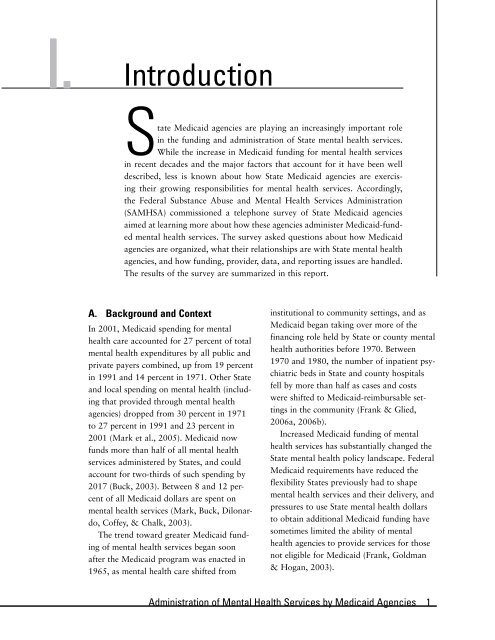Administration of Mental Health Services by Medicaid Agencies
Administration of Mental Health Services by Medicaid Agencies
Administration of Mental Health Services by Medicaid Agencies
Create successful ePaper yourself
Turn your PDF publications into a flip-book with our unique Google optimized e-Paper software.
I. IntroductionState <strong>Medicaid</strong> agencies are playing an increasingly important rolein the funding and administration <strong>of</strong> State mental health services.While the increase in <strong>Medicaid</strong> funding for mental health servicesin recent decades and the major factors that account for it have been welldescribed, less is known about how State <strong>Medicaid</strong> agencies are exercisingtheir growing responsibilities for mental health services. Accordingly,the Federal Substance Abuse and <strong>Mental</strong> <strong>Health</strong> <strong>Services</strong> <strong>Administration</strong>(SAMHSA) commissioned a telephone survey <strong>of</strong> State <strong>Medicaid</strong> agenciesaimed at learning more about how these agencies administer <strong>Medicaid</strong>-fundedmental health services. The survey asked questions about how <strong>Medicaid</strong>agencies are organized, what their relationships are with State mental healthagencies, and how funding, provider, data, and reporting issues are handled.The results <strong>of</strong> the survey are summarized in this report.A. Background and ContextIn 2001, <strong>Medicaid</strong> spending for mentalhealth care accounted for 27 percent <strong>of</strong> totalmental health expenditures <strong>by</strong> all public andprivate payers combined, up from 19 percentin 1991 and 14 percent in 1971. Other Stateand local spending on mental health (includingthat provided through mental healthagencies) dropped from 30 percent in 1971to 27 percent in 1991 and 23 percent in2001 (Mark et al., 2005). <strong>Medicaid</strong> nowfunds more than half <strong>of</strong> all mental healthservices administered <strong>by</strong> States, and couldaccount for two-thirds <strong>of</strong> such spending <strong>by</strong>2017 (Buck, 2003). Between 8 and 12 percent<strong>of</strong> all <strong>Medicaid</strong> dollars are spent onmental health services (Mark, Buck, Dilonardo,C<strong>of</strong>fey, & Chalk, 2003).The trend toward greater <strong>Medicaid</strong> funding<strong>of</strong> mental health services began soonafter the <strong>Medicaid</strong> program was enacted in1965, as mental health care shifted frominstitutional to community settings, and as<strong>Medicaid</strong> began taking over more <strong>of</strong> thefinancing role held <strong>by</strong> State or county mentalhealth authorities before 1970. Between1970 and 1980, the number <strong>of</strong> inpatient psychiatricbeds in State and county hospitalsfell <strong>by</strong> more than half as cases and costswere shifted to <strong>Medicaid</strong>-reimbursable settingsin the community (Frank & Glied,2006a, 2006b).Increased <strong>Medicaid</strong> funding <strong>of</strong> mentalhealth services has substantially changed theState mental health policy landscape. Federal<strong>Medicaid</strong> requirements have reduced theflexibility States previously had to shapemental health services and their delivery, andpressures to use State mental health dollarsto obtain additional <strong>Medicaid</strong> funding havesometimes limited the ability <strong>of</strong> mentalhealth agencies to provide services for thosenot eligible for <strong>Medicaid</strong> (Frank, Goldman& Hogan, 2003).<strong>Administration</strong> <strong>of</strong> <strong>Mental</strong> <strong>Health</strong> <strong>Services</strong> <strong>by</strong> <strong>Medicaid</strong> <strong>Agencies</strong> 1
















